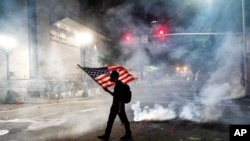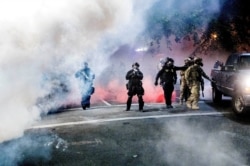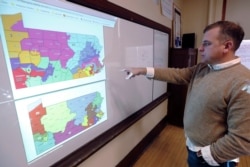When he looks at the genesis of today's Black Lives Matter protests, activist and professor Todd Gitlin sees the reaction of a majority against control by a minority.
Protesters, angered by racial, economic and social inequality, are reacting to minority rule, Gitlin said, making a reference to Donald Trump’s Electoral College victory, which gave him the U.S. presidency in 2016, even though he lost the popular vote to Hillary Clinton by more than 2.8 million votes.
“Even before the pandemic, it was clear that inequality was increasingly unsustainable. I mean, people won't abide it beyond a certain point, and we have political institutions that have failed to solve our problems,” says Gitlin, who began a life of activism as a college student against nuclear weapons and the Vietnam War, and then as a professor at the University of California, Berkley for divestment in South Africa to protest apartheid -- a system of institutionalized racial segregation.
Now a professor of journalism and sociology at Columbia University, he added, “We have an undemocratic political system that doesn’t even acknowledge that people have equal rights to participate in the political process.”
Gitlin lays partial blame on the Electoral College, which he views as “a rickety 18th-century institution founded in utterly different circumstances.”
The Founding Fathers established the Electoral College in the Constitution, one of the nation’s founding documents. It’s a process where U.S. presidents are not elected by the popular vote. When people vote for a presidential candidate, they are actually voting for a candidate's preferred electors.
Each state has the same number of electors as it has members of Congress, one for each member in the House of Representatives in addition to two senators. In most states, the presidential candidate who wins the state’s popular vote is awarded all of the state’s electors in a “winner take all” system.
“There is nothing sacred about state boundaries and no reason why residents of one region should be handicapped in the final tally,” Gitlin says. “The principle ought to be: One citizen, one vote.”
Republicans and conservatives generally favor the Electoral College and oppose a national majority voting system for electing presidents.
“I think it’s a better way of getting a president who represents a broader spectrum of the American people,” says Hans von Spakovsky, a senior legal fellow at The Heritage Foundation and a former member of the Federal Election Commission. “You could simply campaign in the big cities on the coast to become president. You could ignore most of the rest of the country, particularly the more rural areas in the smaller states. And the national Electoral College system, I think, actually prevents that kind of behavior.”
Von Spakovsky dismisses the notion of minority rule, pointing out that Republicans hold 26 governorships across the country, while Democrats have 24.
In all, five U.S. presidents have won the presidency, despite losing the popular vote. Most recently, in addition to Trump, Republican George W. Bush became president after winning the Electoral College, despite losing the popular vote to Democrat Al Gore.
“They have enabled minority rule,” Gitlin says. “The Trump movement is an attempt to retard a change that's already underway. And it's only possible for them to do so because of the undemocratic Electoral College and various antidemocratic measures.”
One of those measures, in Gitlin’s view, is gerrymandering. That’s the practice of manipulating the boundaries of political districts within a state with the intention of giving an unfair political advantage to a particular party.
“It's something that's been with us for a very long time, actually since the very beginning of the country, and people have always complained about it,” says von Spakovsky. “But it is just simply part of our political system, and no one really has ever come up with any kind of remedy or solution that would prevent that from happening without infringing on the rights of Americans.”
While there is no meaningful movement to change the Electoral College system, several states are trying to enact redistricting reforms. Rather than having state lawmakers and governors redraw voting districts for seats in the U.S. House and state legislatures, a growing number of states are turning that duty over to special commissions or are trying other changes to reduce partisan gerrymandering.









